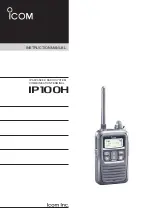
F
CC L
icensing Infor
m
ation
5
be made only by or under the supervision of a person certified as technically qualified to perform transmitter
maintenance and repairs in the private land mobile and fixed services as certified by an organization
representative of the user of those services. Replacement of any transmitter component (crystal, semiconductor,
etc.) not authorized by the FCC equipment authorization for this radio could violate FCC rules.
Note:
Use of this radio outside the country where it was intended to be distributed is subject to government
regulations and may be prohibited.
Safety an
d Gene
ral Infor
ma
tion
6
Safety and General Information
Important Information on Safe and Efficient Operation.
Read This Information Before Using Your Radio.
The information provided in this document supersedes the general safety information contained in user guides
published prior to December 1, 2002.
Transmit and Receive Procedure
Your two-way radio contains a transmitter and a receiver. To control your exposure and ensure compliance with
the occupational/controlled environment exposure limits, always adhere to the following procedure:
•
Transmit no more than 50% of the time.
•
To transmit (talk), press the Push to Talk (PTT) button.
•
To receive calls, release the PTT button.
Transmitting 50% of the time, or less, is important because the radio generates measurable RF energy exposure
only when transmitting (in terms of measuring standards compliance).
Exposure to Radio Frequency Energy
Your Motorola radio is designed to comply with the following national and international standards and guidelines
regarding exposure of human beings to radio frequency electromagnetic energy:
•
United States Federal Communications Commission, Code of Federal Regulations; 47 CFR part 2 sub-
part J
•
American National Standards Institute (ANSI)/Institute of Electrical and Electronic Engineers (IEEE) C95.
1-1992





































